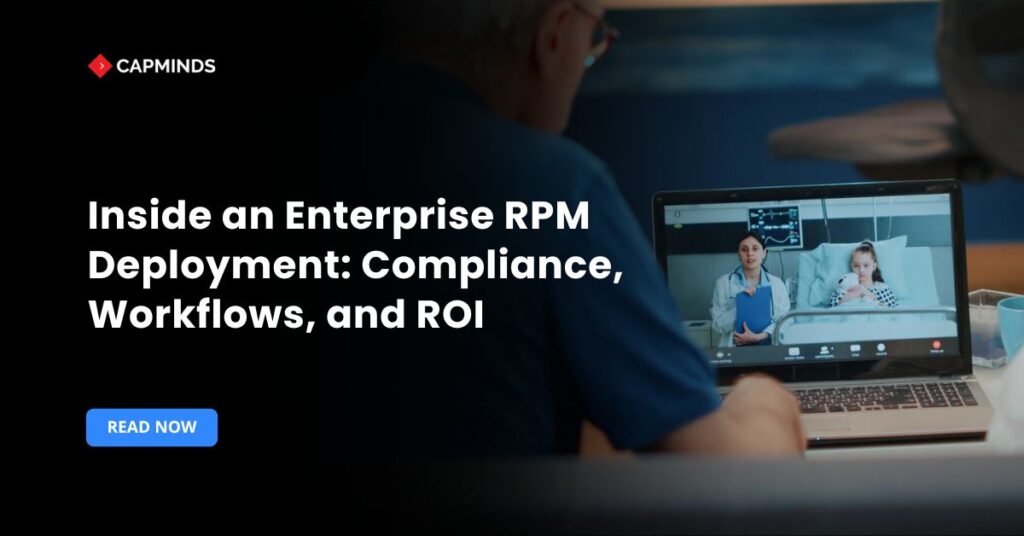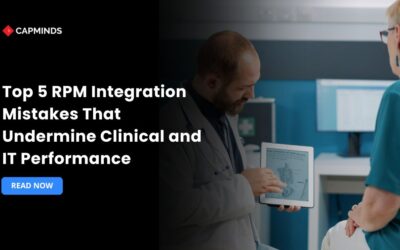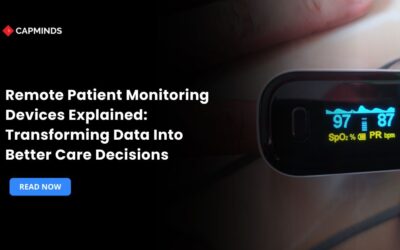Inside an Enterprise RPM Deployment: Compliance, Workflows, and ROI
Delivering high-quality RPM at scale necessitates more than just devices and connections; it also necessitates a strict compliance framework, smooth clinical and technical processes, and a clear business case demonstrating return on investment ROI.
In this blog, you’ll learn the foundations of a successful enterprise-grade RPM deployment with regulatory and privacy standards, end-to-end workflows to keep data flowing, and financial KPIs to justify the investment.
Enterprise RPM’s Strategic Imperative
RPM’s continuous vital sign surveillance and patient interaction outside the clinic can reduce hospitalizations and improve outcomes as healthcare strategies shift towards value-based care and chronic illness management.
Unlike small pilot projects, corporate deployments must handle thousands of patients from various specializations, care teams, and locations. This magnitude presents additional issues for governance, data integrity, and clinician acceptance.
1. Navigating The Compliance Landscape
RPM devices and platforms must meet regulatory and privacy norms.
- PHI protects all data communications, from wearable biosensors to cloud storage, and must be secured in transit (TLS 1.2+) and at rest, with role-based access restrictions that enforce the concept of least privilege.
- Comprehensive recording of user activity and device interactions allows for early identification of illegal access, while an incident response strategy assures prompt reporting to impacted parties and regulators.
- Many RPM platforms are classified as Software as a Medical Device. Compliance with FDA recommendations, including risk classification, 510(k) notification, and quality management ISO 13485, protects both patient safety and organizational responsibility.
Related: How CapMinds’ Smart Meter RPM Integration Cut 35% Record Delays and Boosted Real-Time Monitoring
2. Architecting Scalable RPM Workflows
Patient Enrollment & Device Provisioning
- The centralized enrollment gateway interfaces with EHR to seamlessly synchronize patient data, diagnoses, and treatment plans.
- With zero-touch provisioning, connected devices such as blood pressure cuffs, glucometers, and weight scales are pre-configured with patient IDs and securely linked to the cloud platform before shipment or clinic pickup.
Data Capture and Integration
- Adopting HL7 FHIR APIs guarantees that incoming RPM data flows smoothly into the EHR and population health dashboards, eliminating manual charting and lowering transcription mistakes.
- Local device gateways use edge computing to assess data quality and optimize bandwidth by batching transmissions during off-peak hours.
Related: The Ultimate Guide to Building a Unified Patient Record Strategy with EHR, Telehealth, & RPM
Clinical Review and Alerting
- Automated alarms notify on-call nurses of major deviations such as hypertensive crises, while less urgent trends are queued for weekly case reviews.
- Nurses, physicians, and care coordinators may use integrated secure messaging and task management systems to communicate patient RPM data and assign follow-up calls, telehealth visits, or prescription modifications.
Patient Engagement and Education
- Patients get automated reminders via SMS, email, or in-app notifications to submit readings, complete symptom questionnaires, or access specialized instructional information.
- Patients may use in-app chat or planned telehealth sessions to ask questions, report side effects, and request technical help, increasing adherence and satisfaction.
3. Measure ROI: Quantifying Clinical and Financial Gains
Clinical Outcomes Metrics
- Monitor 30 90 day readmission rates for habitual ailments like CHF, COPD, ahead and after RPM deployment. Within six months, programs frequently observe a 15- 25 reduction in readmissions.
- Track adherence rates like planned readings performed and patient satisfaction scores as pivotal labels of long-term issues.
Financial and Operational Metrics
- Calculate the average cost per prevented admission and extend it to the entire enrolled population. Reducing 50 CHF readmissions at $12,000 each saves $600,000 in gross savings per year.
- Use RPM-specific CPT codes such as 99453, 99454, 99457, 99458 to track monthly billable services. A mature program with 2,000 active patients may produce more than $400,000 in reimbursement annually.
Total Cost of Ownership
- Consider device procurement, shipping, IT structure, software licensing, and staffing for monitoring and case management.
- Model the time to ROI by evaluating cumulative reimbursement and cost savings against TCO. Many organizations reach break-even within 9-12 months.
Best Practices for Enterprise RPM Success
- To oversee policy, performance, and budget alignment, make a steering group of clinical lawyers, compliance officers, IT engineers, and finance directors.
- Start with a high-volume, high-impact case group, similar to heart failure cases who have just been discharged, to streamline processes, show benefits, and induce support for broader relinquishment.
- Reiterate using the insights gained from data. Estimate crucial performance pointers regularly, get feedback from providers, and update clinical thresholds and engagement strategies.
- To streamline procurement and support, manage the seller ecosystem by uniting with device manufacturers, connectivity aggregators, and analytics providers under a single service-position agreement.
Related: RPM in Healthcare and How it Ensures Quality Care to Patients
Framework for Enterprise RPM Deployment
| Phase | Key Activities |
| Assessment & Planning | Identify patient cohorts, compliance needs, device requirements, and staffing plans |
| Pilot Deployment | Enroll a small cohort, test processes, refine technology, and workflows |
| Compliance Build-out | Ensure HIPAA, FDA, and billing validations are met; conduct training and documentation |
| Scale Deployment | Onboard more patients, integrate data into EHRs, and expand monitoring teams |
| Performance Tracking | Monitor clinical issues, functional KPIs, patient satisfaction, and ROI |
| Continuous Improvement | Use performance data to upgrade protocols, optimize processes, and scale further. |
Scale Smarter with CapMinds: Your Enterprise RPM Success Partner
At CapMinds, we empower healthcare enterprises to deliver RPM at scale securely, compliantly, and profitably. From device integration to ROI tracking, our digital health solutions are designed to optimize your care delivery and operational performance.
Here’s what CapMinds brings to your enterprise RPM journey:
- End-to-End RPM Implementation – From patient onboarding to device provisioning and clinical workflows
- Compliance & Security – HIPAA, GDPR, FDA (SaMD), ISO 13485-ready frameworks to mitigate risks
- HL7/FHIR Integration – Real-time EHR sync, automated alerts, and edge-optimized data streaming
- Billing Optimization & ROI Modeling – CPT tracking, TCO calculation, and reimbursement acceleration
Whether you’re scaling post-discharge heart failure programs or building RPM into your chronic care strategy, CapMinds is your strategic ally. Let’s future-proof your RPM deployment safely, intelligently, and efficiently.
Contact CapMinds today for a custom consultation!




